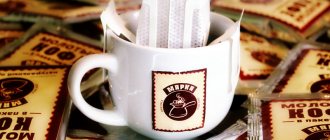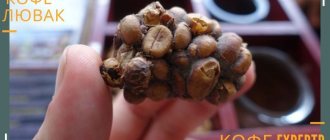What is freeze-dried coffee and how does it differ from other types?
Sublimation means special processing of grains. When making regular instant coffee, high pressure is used, as a result of which the coffee molecules are destroyed. The difference between sublimation is that it makes it possible to preserve them, so the resulting coffee is as close as possible to natural coffee, both in its composition and taste.
There is an opinion that freeze-dried coffee is less harmful than instant coffee, mainly because its production does not use as many chemical additives as instant coffee.
Instant coffee is obtained from waste from the production of natural coffee. In the production of freeze-dried coffee, higher quality raw materials are used, and this is the main thing that improves its taste. However, this type of coffee is made in most cases not from Arabica, but from Robusta, a technical variety that contains more caffeine. This happens because it turns out to be much cheaper. And it makes no sense to make it from Arabica, because during the production of freeze-dried coffee, its main advantages - taste and aroma - disappear.
What is granulated coffee?
Granulated coffee is a type of instant coffee that is obtained by quickly drying coffee extract.
The initial stage of granulated coffee production coincides with the freeze-dried type: roasting, grinding and boiling of coffee beans, followed by steam removal.
The coffee extract then diverges: to produce granulated coffee, the concentrate is sprayed in an even layer and dried under high pressure. The result is a powdery mass. At the last stage it is treated with steam. Under the influence of water vapor, the powder collects into loose granules with uneven edges. Unlike powdered coffee, granulated coffee does not stick to the spoon.
Composition and calorie content of instant freeze-dried coffee
The composition of coffee includes oils, flavors and various additives.
The composition of coffee primarily includes coffee oils, which are obtained during the manufacturing process from natural beans. The remaining components are chemical additives - dyes, flavors, preservatives and others.
If we consider the percentage of the composition of the instant drink, then most of all it contains ash - approximately 10%, caffeine on average 2.8%.
Caffeine also contains substances such as dextrin - 5.8%, trigonelline - 4.5%, sugar - 1.8% and moisture up to 4%. Also, 100 grams of freeze-dried coffee contains 95 kilocalories. This is what is generally contained in many of your favorite drinks.
Comparative characteristics
So, we found out that both types of instant drinks under consideration are produced partially using identical technology, and the same raw materials are used in production - natural grains. What's the difference then? Let's try to figure it out.
| Sublimated | Granulated | |
| Technology | Brewed natural coffee is first frozen, then all moisture is removed by cold | The brewed natural drink is dried under pressure |
| Taste | It is often supplemented with various flavors (of natural origin, according to the manufacturers), and coffee oils. Has a richer and more pleasant taste than granulated | Most often, granulated is less saturated and does not have such a pronounced taste as freeze-dried |
| Appearance | It has a more neat appearance than sublimated. It is small pyramid-shaped particles the color of milk chocolate | Presented in the form of various loose lumps of dark brown color |
| Benefit | Doubtful, since both products have, in fact, a very distant relation to a natural drink and even when saturated with oils (if this is really the case), the degree of usefulness is close to zero | Doubtful |
| Price | Medium to high | Low to Medium |
Sublimation of coffee beans and difference from simple instant
Instant coffee prepared according to the usual recipe
This type of coffee is made from high-quality coffee beans. They are roasted and ground to the consistency of flour, after which the coffee is brewed in protected, airtight containers for some time. During this, steam is generated. It contains essential oils from grains. This steam is removed from the main tank and accumulated to release essential oils.
Next, the quick freezing method is used. During the process, all the liquid that was in the coffee mass is completely frozen. After this, the mass is crushed so that small granules are obtained. They are aromatized with essential oils extracted from the steam.
Conclusions:
- Freeze-dried coffee is made using modern multi-stage technology, thanks to which its composition is almost identical to natural coffee.
- To produce this variety, a technical variety of beans is used - robusta, which contains a higher amount of caffeine and has a tart, bitter aftertaste.
- It is impossible to accurately calculate the amount of caffeine in a serving of freeze-dried coffee, so this drink should not be consumed by children, people with high blood pressure and heart problems.
- If desired, healthy people can, in rare cases, consume freeze-dried coffee without harm to the body. If you drink this coffee occasionally, it will not have any negative effects.
- When choosing instant coffee, it is important to pay attention to the integrity of the packaging and the appearance of the granules themselves. If the can is damaged, and the coffee itself has changed its color or aroma, it means that it was prepared incorrectly, or the manufacturer is trying to sell granulated coffee under the guise of freeze-dried coffee.
Benefits, harms and contraindications of freeze-dried coffee
Coffee and the substances it contains have a lot of beneficial properties for the body.
Opinions about the dangers of freeze-dried coffee differ. Freeze-dried coffee, according to manufacturers, does not cause any harm, while retaining all the important characteristics of natural coffee beans.
But there are negative properties. First of all, this type of coffee harms the stomach and other organs of the digestive system.
The grounds that remain at the bottom of the mug are considered the most dangerous. It contains tannins that irritate the gastric mucosa and, with prolonged exposure, cause gastritis and even stomach ulcers.
The problem is that this drink is poison for the digestive system, and the liver perceives coffee the same way. As with other similar substances, it struggles with it, and if you drink coffee constantly, the liver begins to fail, and as a result, there is a possibility of developing liver diseases.
Caffeine and other active substances in coffee can be harmful if consumed uncontrolled
This drink is especially harmful when drunk on an empty stomach. This stimulates the secretion of digestive juice, and the stomach, having nothing in itself to process, begins to digest its walls. Next, heartburn develops, and when drinking a mug of coffee on an empty stomach becomes a habit, gastritis occurs over time, which in turn leads to an ulcer, which leads to even worse consequences and even oncology.
What is the benefit
Let's talk about coffee: the benefits and harms of the freeze-dried type. The drink is beneficial for the body only if it is brewed correctly. In this case, it retains useful substances.
Freeze-dried crystals contain amino acids. According to doctors, this substance prevents aging.
Connoisseurs of the drink use coffee as a source of nicotinic acid. It is useful if your cholesterol levels are high.
Thanks to the release of adrenaline and serotonin, coffee lovers feel a surge of strength and positive energy.
Caffeine is beneficial for low blood pressure.
Coffee activates mental work, enhances memory, and saturates the body with microelements: magnesium, iron, phosphorus.
A sublimate drink without additives or snacks has a positive effect on metabolism and accelerates the breakdown of fats. Coffee lovers lose weight faster.
You will only benefit from sublimate if consumed in moderation. 1-2 cups per day is enough.
Freeze-dried coffee recipes
Here are a couple of recipes for making freeze-dried coffee.
Coffee with milk and cinnamon
Coffee with milk and cinnamon
You will need:
- 1-2 teaspoons of freeze-dried coffee;
- Sugar;
- 40-60 ml of milk (recommended with a fat content of more than 3%);
- A little cinnamon to taste;
- 160-180 ml of water.
Preparation procedure:
- Pour the required amount of sugar and coffee into the mug.
- Fill with hot water.
- Let it brew for 2-3 minutes.
- While it sits, heat the milk a little.
- You can whip the milk in advance to suit your needs.
- Next, add it to the drink and stir.
- Sprinkle with cinnamon.
- For those who like interesting flavor combinations, you can use coconut milk for a more exotic taste.
Freeze-dried iced coffee
Coffee with ice and milk is perfect for refreshing on a hot day.
To prepare a cold drink you will need:
- 5 teaspoons of coffee;
- Sugar to taste;
- A little vanilla;
- 0.25 l of water;
- 0.25 liters of milk.
Preparation procedure:
- Fill a cup with coffee and sugar with hot water and stir.
- Let cool.
- Sprinkle a little vanilla on top and pour the drink into an ice tray.
- Freeze, add coffee ice to cold milk and leave in the refrigerator for 20 minutes so that the ice melts a little and everything is mixed.
Excursion to production
From the receipt of raw materials to the factory to the packaging of the finished product, a long, painstaking process occurs. The initial stage is no different from the production of granules and powder. Raw coffee beans are roasted and very finely ground. The powder is then poured with hot water to obtain a concentrate. In sealed containers, the intermediate product is thoroughly boiled for 2-3 hours. Using steam extraction equipment, coffee oil is extracted from the raw material.
At the next stage, freeze-dried coffee is made directly. The grounds are placed in a column with a powerful freezer. To preserve its properties, the concentrate must be frozen instantly. Subsequently, exposure to vacuum quickly removes moisture from the crystals. Next, the technique crushes uneven pieces, achieving the desired shapes and sizes. Now the previously extracted oil is added to the granules for taste and aroma.
When sublimating, as a rule, chemical enhancers of smell and taste are not used. This is not necessary due to the processing features.
Review of manufacturers and brands, how much the products cost
EGOISTE
Egoist coffee is produced using the new In-Fi technology.
Each granule of the Egoist brand contains 20% natural ground Arabica. The new In-Fi manufacturing technology gives a strong, rich, slightly harsh aroma and a wonderful, slightly bitter aftertaste.
UCC
Exclusive technology allows us to produce a good premium drink. Light pleasant fruity shades, lack of bitterness and a soft aftertaste allow you to drink this noble drink without sugar. Caffeine-free flavors are also available. Medium roast, a huge range of flavors that will satisfy everyone's preferences. An excellent option for those who watch their body and count calories.
CARTE NOIRE
Freeze-dried coffee CARTE NOIRE
It has a high caffeine content - 4%. Pleasant, slightly bitter with a rich, unique coffee aroma. A premium drink for true connoisseurs of strong black coffee.
BUSHIDO
All blends contain ideally selected grains from Africa and Indonesia. Interesting chocolate-coffee aftertaste and high caffeine content - 3.2%. There are no calories. This brand is the most expensive and at the same time popular.
Jardin
Jardin brand coffee from Kenya
Delicate flavors of fruit and vanilla, floral aroma. The strength is medium, pleasant, with a slight subtle aroma. Jardin is distinguished by the ability to easily select the degree of roasting and the type of blend based on digital designations.
Davidoff
Davidoff has a clear and bright taste of dark chocolate, a light aftertaste and low calorie content. A good choice for true coffee lovers.
Moccona
Freeze-dried coffee Moccona
Quite bitter, interesting pleasant smell. Unique packaging that protects against counterfeiting. Good value for money.
History of origin
New discovery
Sublimation technology was first used during World War II. American scientists from the National Research Corporation used it to create antimicrobial drugs. And also when transporting blood serum to medical centers.
Sublimation technology continued to be used after the war. NRC specialists have made a new discovery - if you freeze dry foods, they retain more useful components than when you fry them.
Demand for the method
The Americans decided to use technology to create instant coffee. The experiments turned out to be successful. In 1965, Nestle presented a new product. Coffee lovers in America and Europe learned about freeze-dried coffee: what it means and how it differs from instant coffee in powder and granules. We'll talk about this below.
The taste and quick preparation made the drink popular among coffee lovers.
Manufacturers in Europe are also interested in how freeze-dried coffee is made. They entered into contracts with the Americans and started the manufacturing process using this method. By 1980, 40% of the coffee produced by Europeans was freeze-dried.
The experiments continued
The sublimate differed from the natural drink in taste. Starbucks spent 20 years looking for a way to eliminate the difference.
Experts used different types of grains. We experimented with roasting methods and freezing temperatures.
Only at the beginning of 2000 was it possible to achieve results. The new product was called “Stardust”.
In 2020, Starbucks entered into a contract with the Swiss company Nestle. She received the rights to sell Starbucks brand products, including sublimate coffee.
We talked about freeze-dried coffee: what it means and how it came about. Now let's look at how it is made.
Interesting! Recipes for making Irish coffee at home, composition and proper serving
What is good coffee and how to choose a quality product
Real coffee has granules of the same color with shine.
No one is safe from counterfeit even now. However, there are a few tips that will help you purchase a quality product.
Always look at the size and color of the granules, which should be the same in size, clear in color, and slightly shiny.
If the color is unsaturated and too dark, the purchase should be abandoned; the manufacturers did not follow the technology.
It is worth remembering that a drink in a can (tin or glass) is more difficult to counterfeit. Not only economy class goods are sold in soft packaging, but also dubious products from little-known manufacturers.
Coffee in glass and tin cans is more difficult to counterfeit
You must read the product name carefully. You can just not notice one changed letter in the name of a well-known manufacturer and buy a fake. Be sure to check the bottom of the jar - the granules there should be intact. The main features of high-quality coffee are light brown or chocolate color of the same tone and homogeneous granules without any impurities. Check the integrity of the packaging - the taste and aroma of natural instant coffee will deteriorate irrevocably due to depressurization.
Main differences
First of all, sublimated and granulated goods differ from each other in production technologies.
In addition, organoleptic indicators are striking. Freeze-dried coffee granules are large, dense, smooth, light brown in color, and pyromide-shaped. Granular has loose granules, similar to dry coffee lumps of a dark color. The aroma of the granules depends on the additives with which the dried extract was processed. Freeze-dried smells better due to the use of natural essential oils, but the true composition of the flavoring mixture is not known. A high-quality granular product may smell better than a cheap sublimate. Taste qualities also depend on the manufacturer, brand, and product line.
The price of freeze-dried coffee is much higher than granulated coffee, due to the expensive sublimation, raw materials used, and packaging. There is no point in packaging expensive goods in cheap containers. More often, glass jars are used for sublimate, which allow you to see the contents and protect well from moisture. The packaging can also be a gift, and regular plastic bags are also available. The latter are used to reduce the cost of products or low-quality, cheap goods.
So the main differences are:
- manufacturing technology;
- appearance, taste and aroma;
- cost of production.
How to produce
The process of obtaining freeze-dried coffee is aimed at extracting the maximum amount of flavoring and aromatic substances from natural beans. Selected coffee beans are used for production - this guarantees a high-quality finished product.
The grains are first fried, gases are removed from them and ground to a powdery state. Then the grinding is poured into special sealed metal containers and boiled for several hours. The steam generated during cooking is directed through pipes. Along with the steam, essential oils are also released, which will later be needed to add flavor to the drink.
The resulting coffee mass is subjected to shock freezing, then vacuum removal of moisture occurs. This drying method makes the composition of the freeze-dried product closest to natural.
The thoroughly dried concentrate is crushed into small crystals.
At the last stage, the specific coffee taste and aroma are returned to the granules. To do this, they are soaked in essential oils in combination with additional flavors. Next, they are packaged in airtight packaging.
Coffee granules of the same size are considered an indicator of correct adherence to the preparation procedure. To visually see the quality, it is better to buy products in transparent jars.
Advantages and disadvantages
It is known that freshly ground coffee is more healthy and harmless, but freeze-dried coffee can also be beneficial for the human body. It has a positive effect on the body, which consists of:
- normalization of low pressure;
- lowering cholesterol levels;
- activation of the brain;
- breakdown of fats;
- removal of toxins;
- active transformation of carbohydrates into energy;
- fight against aging of body cells.
You should know when to use caffeine-containing products in moderation, otherwise their positive qualities will turn into negative ones and harm your health. In addition, coffee is often addictive: the larger the daily dose, the more difficult it is to give up the aromatic drink.
Experts identify a number of main negative consequences when abusing a freeze-dried product:
- disturbances in the functioning of the cardiovascular system;
- allergic reactions;
- insomnia and irritability;
- calcium leaching;
- problems with potency;
- nausea and dizziness;
- diseases of the gastrointestinal tract;
- load on the kidneys and liver.
Instant coffee is contraindicated for pregnant women, as it can affect the development of the unborn child.
What kind of coffee do you drink?
Granulated
Sublimated











